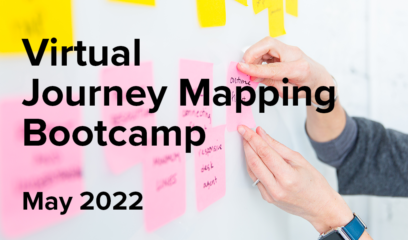For the past few weeks, I’ve posted answers to some of the questions I got during my Qualtrics’ CX Week webinar “10 Ways To Use Customer Journey Maps.” (You can download the slides here. Or watch the webinar—just register for free at CXWeek.com and look for my webinar on the Wednesday agenda.)
In Part 1 and Part 2 of this series, I talked about the elements of a journey map and how to run a journey mapping workshop. This week I’ll focus on the research you need to do in order to map and validate your customer journey.
What is more effective: To create journey maps based on actual customer stories or to create journey maps based on stories created (imagined) by employees?
Customer journeys that are imagined by employees can be incredibly dangerous—because they’re filled with assumptions that might be incomplete or downright wrong. That said, you’ve got to start your journey mapping process somewhere, and assumption-based journey maps are a natural place to begin. Even if the journey they depict isn’t 100% accurate, they’re a valuable tool for getting employees to empathize with customers and highlighting spots where additional customer research is needed.
Here’s what I’d recommend: Create an assumption journey map with employees from various departments—that way, you can draw on their various perspectives and insights. Then go out and do qualitative research with customers to validate (or invalidate) those journeys. That can include at-home ethnography, diary studies, or one-on-one interviews. One time- and cost-efficient research method is to bring multiple customers into a workshop on single day, have them walk through the assumption journey maps, and then ask them to change the maps to match their own collective reality.
Without quantitative research data, what is best practice for determining emotional state throughout a customer’s journey?
It’s important to understand the relationship between quantitative and qualitative data—and what kind of insights each can provide.
Quantitative data is great at helping you understand customers’ overarching attitudes towards your company, where their pain points are, and what they do as they interact with you. What you can’t get from quantitative inputs like surveys, web analytics, purchase history, etc. is a deep or nuanced understanding of customers’ underlying emotions, attitudes, or motivations—or what exactly an ideal solution to their problems looks like. For that, you need to complement your quantitative data with qualitative research like observations and one-on-one interviews. (You can find more detail on the roles of quant and qual data in my recent post, Quant Data, Qual Data: Use Just One To Derail Your CX Efforts.)
So to answer your question, I’d suggest inviting your customers to a journey mapping workshop where you can ask them directly about their thoughts and feelings at each step of the journey.
Are there some tips you can share in regards to how customer journey mapping exercises pertain to business-to-business (B2B) corporate experiences, especially with large corporate customers where you have often more than one stakeholder interacting with the provider in a journey?
I work with many B2B companies, and journey mapping is just as valid and important as it is with their business-to-consumer (B2C) counterparts. In each type of business, you have to start with your persona—whose journey are you mapping out?
Just like B2C companies, B2B organizations often have several different personas whose journeys need to be mapped. But while a B2C company’s personas’ journeys may never cross paths, the journeys of a B2B organization’s personas may be intricately connected.
Consider the journey of a Chief Financial Officer who has to approve a major software purchase. She hands off the details of the transaction to her finance team before adding her signature. As soon as the paperwork is in place, the client’s Chief Technology Officer steps in to oversee the integration of this new software platform. And then, throughout the onboarding process, the company’s developers and sys admins step in for the required customization. Towards the end of the journey, the internal training team ensures a successful rollout to the company’s employees.
While each of these roles may need to have a journey map that’s documented in detail, the unified journey—including key handoffs amongst the various roles—is often equally important. Don’t shy away from high-level journey maps that illustrate the flow of actions and information from role to role.
Effective B2B journey mapping also involves extensive customer research. The B2B companies I’ve worked with bring in employees from their clients’ organizations to participate in workshops. While this may initially seem like a recruiting challenge, B2B journey mapping participants are usually more than happy to take part in an initiative that will help make their jobs easier.
***
If you have additional questions about journey mapping—or would like to share a story about your own journey mapping experience—please leave a comment.




